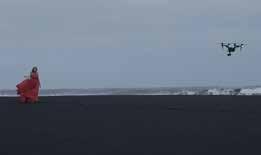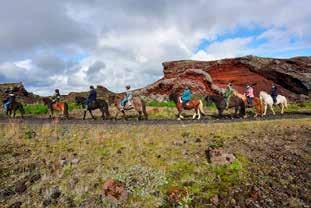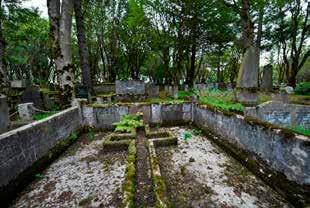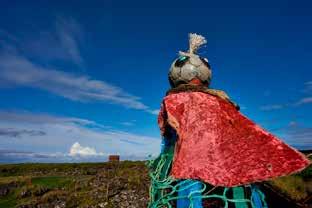
4 minute read
Filming in Iceland
Iceland’s unique landscape, from bubbling hot springs to erupting volcanoes, attracts film productions from around the world. There’s increasing demand to capture Iceland’s dramatic landscapes in feature films and television series and to take advantage of an attractive incentive scheme.
Over the past few years, some of the biggest movies and television shows have been filmed in Iceland, including Star Wars: The Force Awakens, Thor: The Dark World, Justice League, and Game of Thrones.
Icelandic director Baltasar Kormákur recently opened two film studios in Iceland, RVK Studios, to accommodate the growing demand. RVK Studios has produced the Hollywood films Two Guns, Contraband, and Everest and the Icelandic television series Trapped and Katla.
Iceland may seem like an unlikely location to film, but new productions are announced all the time as the beauty of the island draws them in. Indeed, Iceland’s landscape is unrivalled, from wondrous waterfalls to the desert-like highlands; the contrast of landscapes is breathtaking.
Another Iceland-based production company, Truenorth, has worked on productions including The Northman, Dune, The Midnight Sky, and Blade Runner 2049.
Attractive tax incentives
Another part of Iceland’s appeal is due to the Icelandic government’s programme to reimburse up to 35% of the costs incurred while producing films and television programmes in Iceland. Production cost payments to employees and contractors are accepted if they are verifiably taxable in Iceland.
All productions for feature films, television shows and documentaries filmed in Iceland are eligible for a 25% refund, no matter the project’s total cost. To receive 35%, a production must fulfil three requirements, according to the legislation.
First, production costs incurred during the production of the film or television material shot in Iceland must be a minimum of ISK 350 million (EUR 2.5 million). Next, the project must have a minimum of 30 working days in Iceland, either filming days or defined post-production working days. Of the 30 working days, a minimum of 10 filming days in Iceland is always required.
Lastly, the number of staff working directly on the project should be 50 at a minimum and amount to 50 working days. It is required that both salary and payments to employees and contractors be taxed in Iceland.
Iceland is an increasingly popular destination for filming for a very good reason. Unrivaled scenery, experienced film crews, local talent and impressive tax incentives continue to lure filmmakers.




HAPPY HORSEMEN IN RAUÐHÓLAR

These German travellers had fun horse riding around Rauðhólar. Rauðhólar is a cluster of pseudo craters on the outskirts of Reykjavík. The craters formed about 5,000 years ago when the Elliðaár lava flowed over moorland and the water under the glowing lava exploded. Beautifully shaped red-coloured spatter cones then formed during the steam explosions on the surface of the lava. Sand quarrying was extensive in Rauðhólar in the middle of the 20th-century, to make, among other things, the underlay for Reykjavík Airport in Vatnsmýri during the Second World War. The Rauðhólar area was protected in 1961 and is now a public park. Many people and animals make their way around the area on days with good weather, as it is only a stone’s throw from the capital.
The light was incredibly beautiful and dramatic by Reykjavíkurtjörn yesterday afternoon. The Office of the President of Iceland is the white house behind the bridge. Hallgrímskirkja is at the top left, in shadow.
SUN ON SÓLEYJARGATA
The Office of the President of Iceland has been at Sóleyjargata 1, or Staðarstaður as the building is called, from 1996. Since Iceland became an independent republic on 17th June, 1944, six individuals have served as President of Iceland. The first President of the Republic was Sveinn Björnsson 1944 – 1952, followed by Ásgeir Ásgeirsson 1952 – 1968 and the third President was Kristján Eldjárn 1968 – 1980. Vigdís Finnbogadóttir, the first elected female president in the world, was the President of Iceland in the years 1980 – 1996. Ólafur Ragnar Grímsson was president from 1996 to 2016, when the current president, Guðni Th Jóhannesson, took over.
GARÐABÆR
The creature received me well early this morning at Álftanes. After all, the weather was good after the wind and rain last night. REYKJAVÍK

STRANGE CREATURES ON BALASTRÖND BEACH

On the beach by Bali, where Garðabær and Hafnarfjörður meet on Álftanes, there are about thirty strange creatures. An elderly fisherman and artist, Jón Guðmundsson, has been cleaning the shore of the rubbish that drifts ashore and creates these fine figures that stand there in Hafnarfjarðarhraun on Balaströnd. The lava is from an eruption from the Búrfell volcano in Reykjanes 7,500 years ago that flowed 12 km (7 miles) to the sea. IN PEACE AND QUIET
In 1838, 183 years ago, Guðrún Oddsdóttir became the first person to be laid to rest in Hólavallagarður, a new cemetery in Reykjavík. Guðrún, born in 1780, is a watcher, the guardian of this beautiful cemetery in the western part of the city. Art historian Björn Th. Björnsson called the cemetery “Reykjavík’s largest and oldest museum”. It was nominated for the Nordic Council’s Environment Prize in 2005. It is also an incredible source of the history of the art and symbolism, genealogy, architectural trends, crafts and horticulture of a growing town. By 1932, almost all the graves in the park had been allocated, and Fossvogskirkjugarður would take over as the capital’s main cemetery.










